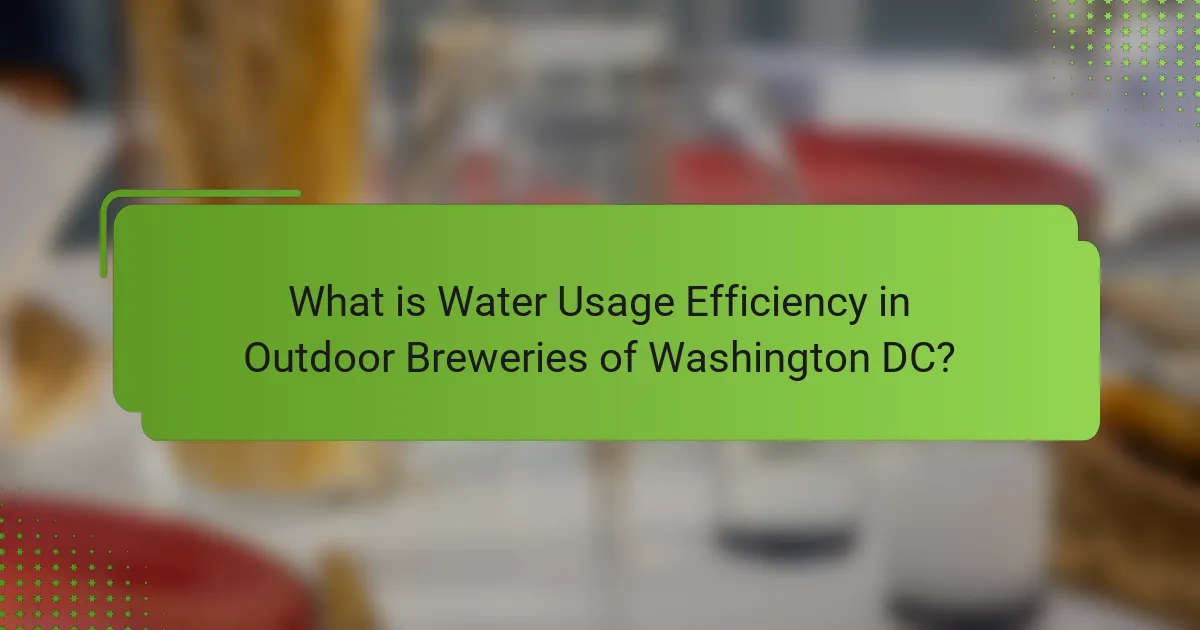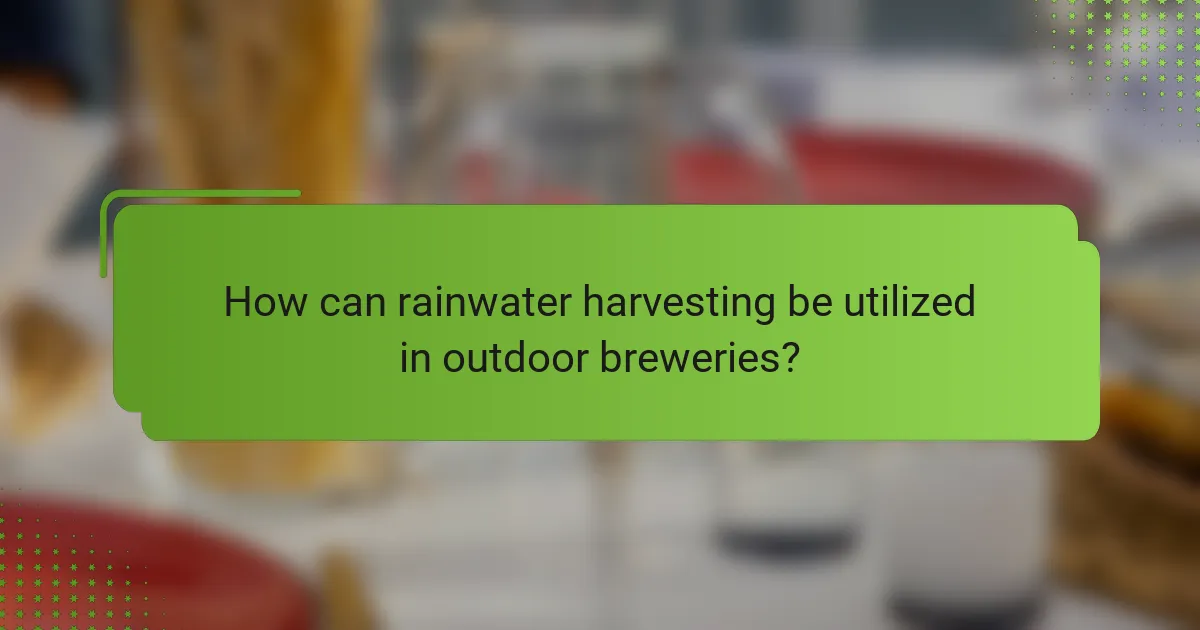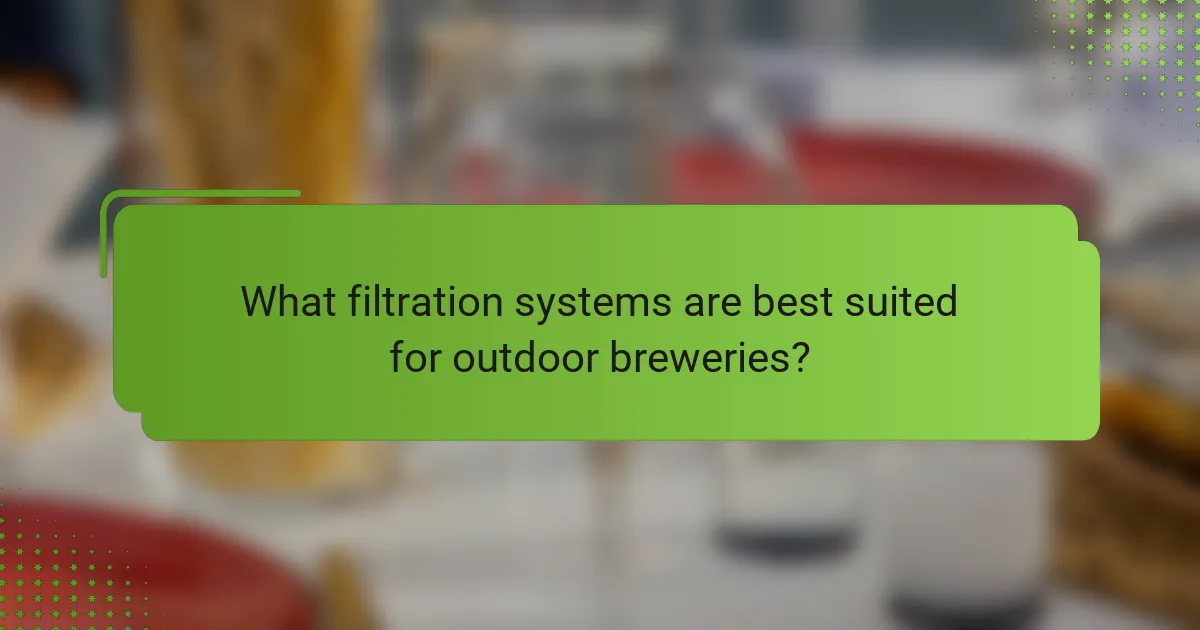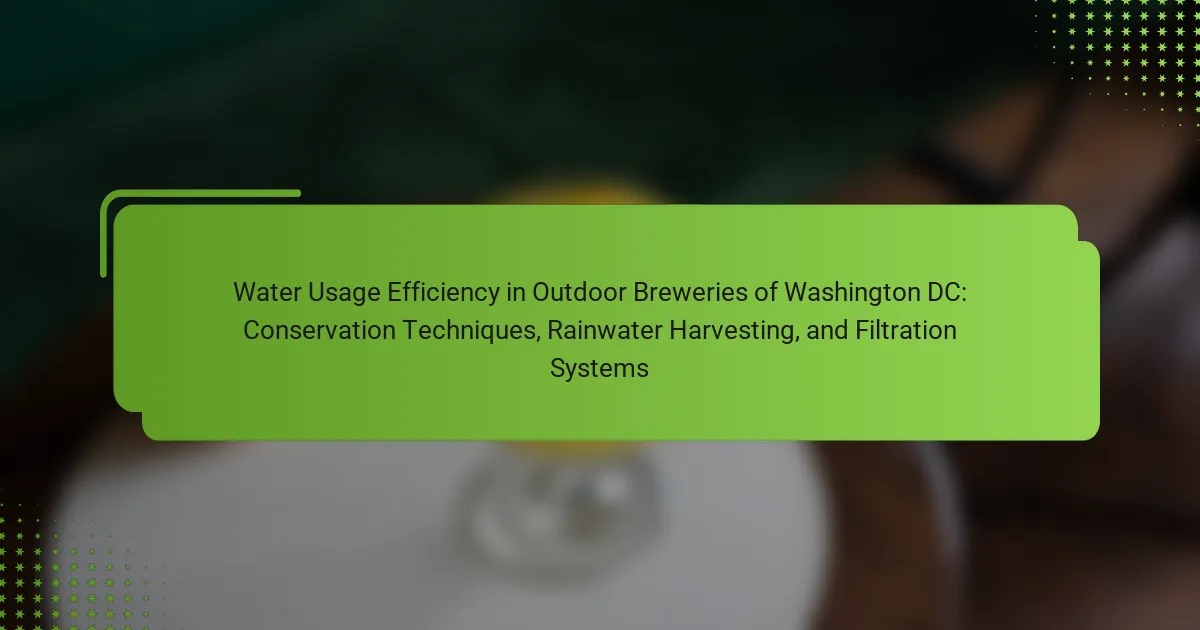Water usage efficiency in outdoor breweries of Washington DC involves the effective management of water resources to minimize waste through various conservation techniques. Key practices include rainwater harvesting, recycling water, and implementing advanced filtration systems such as reverse osmosis and carbon filtration. These methods can significantly reduce water consumption by up to 30%, lower operational costs, and enhance sustainability efforts. The article explores specific strategies outdoor breweries can adopt, including efficient irrigation, greywater recycling, and staff training, to promote a culture of conservation and protect local water resources.

What is Water Usage Efficiency in Outdoor Breweries of Washington DC?
Water usage efficiency in outdoor breweries of Washington DC refers to the effective management of water resources to minimize waste. It encompasses practices such as recycling water, using rainwater harvesting systems, and implementing filtration technologies. Studies indicate that efficient water usage can reduce consumption by up to 30% in brewing operations. Outdoor breweries often adopt conservation techniques to enhance efficiency, including optimizing cleaning processes and utilizing low-water brewing methods. These strategies not only conserve water but also lower operational costs and support sustainability initiatives.
How is water usage efficiency measured in outdoor breweries?
Water usage efficiency in outdoor breweries is measured by calculating the ratio of water used to produce a specific volume of beer. This metric helps breweries assess their water consumption relative to production output. Efficiency is often expressed in terms of liters of water per liter of beer produced. Outdoor breweries may also track water recycling rates and the effectiveness of conservation techniques. For instance, breweries utilizing rainwater harvesting can measure the volume of harvested water against total water usage. Additionally, monitoring evaporation losses during brewing can provide insight into overall efficiency. These measurements help identify areas for improvement in water management practices.
What metrics are used to assess water consumption?
Metrics used to assess water consumption include total water usage, water usage per production unit, and water efficiency ratios. Total water usage measures the overall volume of water consumed over a specific period. Water usage per production unit calculates the amount of water used for each unit of product produced. Water efficiency ratios compare water consumption against production output to evaluate efficiency. These metrics help breweries identify areas for improvement and track conservation efforts.
How do these metrics compare across different breweries?
Metrics such as water usage per barrel, efficiency of conservation techniques, and rainwater harvesting rates vary significantly across different breweries. For instance, some breweries may use as little as 3 to 4 gallons of water per barrel, while others may exceed 7 gallons. The efficiency of conservation techniques also differs; breweries employing advanced filtration systems often report higher water savings. Additionally, rainwater harvesting capabilities can range from minimal collection to systems capturing thousands of gallons annually. These differences highlight the diverse approaches and technologies implemented in Washington DC’s outdoor breweries.
Why is water usage efficiency important for outdoor breweries?
Water usage efficiency is crucial for outdoor breweries due to the high water demand in brewing processes. Efficient water use minimizes waste and reduces operational costs. Water scarcity can impact production capabilities, making efficiency vital. Furthermore, sustainable practices enhance a brewery’s reputation and attract environmentally conscious consumers. In Washington DC, breweries face specific regulatory challenges regarding water usage. By implementing water-efficient systems, breweries can comply with local regulations while conserving resources. Studies show that breweries can reduce water usage by up to 50% through effective conservation techniques. This not only benefits the environment but also improves profitability.
What environmental impacts are associated with inefficient water use?
Inefficient water use leads to several significant environmental impacts. It contributes to water scarcity by depleting local water sources faster than they can replenish. This over-extraction can harm ecosystems dependent on those water sources. Inefficient practices also increase energy consumption, as more energy is required for water treatment and transportation. Higher energy usage results in increased greenhouse gas emissions. Additionally, poor water management can lead to soil degradation and reduced agricultural productivity. It can also result in increased pollution, as runoff from over-irrigated areas carries fertilizers and pesticides into waterways. These factors collectively threaten biodiversity and disrupt natural habitats.
How can improved efficiency affect operational costs?
Improved efficiency can significantly reduce operational costs in outdoor breweries. By optimizing water usage, breweries minimize waste and lower utility bills. For instance, implementing rainwater harvesting systems can decrease reliance on municipal water sources. This reduces expenses associated with water procurement. Additionally, efficient filtration systems enhance water quality, leading to less product loss. Studies show that breweries adopting these techniques can save up to 30% on water-related costs. Overall, enhanced efficiency directly correlates with lower operational expenses in the brewing industry.
What are the key challenges faced by outdoor breweries in Washington DC regarding water usage?
Outdoor breweries in Washington DC face several key challenges regarding water usage. These challenges include limited access to water sources. Outdoor breweries often rely on municipal water supplies, which can be inconsistent. Additionally, regulatory restrictions on water usage can complicate operations. Seasonal variations in water availability also pose challenges for outdoor breweries. High water costs in urban areas can impact financial sustainability. Lastly, the need for efficient water management practices is essential to minimize waste and ensure compliance with environmental regulations.
What regulatory factors influence water usage in breweries?
Regulatory factors influencing water usage in breweries include local water use permits and state water quality regulations. These permits dictate the volume of water a brewery can extract from local sources. Additionally, breweries must comply with environmental regulations concerning wastewater discharge. The Clean Water Act requires adherence to standards that prevent pollution in water bodies. Local municipalities may impose additional restrictions based on regional water scarcity. Compliance with these regulations ensures sustainable water management practices. Non-compliance can result in fines and operational restrictions.
How do seasonal variations affect water availability?
Seasonal variations significantly affect water availability. During spring and summer, higher temperatures increase evaporation rates, reducing surface water levels. Rainfall patterns also change, with summer months often experiencing droughts. Conversely, winter can lead to snow accumulation, providing water as it melts in spring. According to the U.S. Geological Survey, seasonal precipitation impacts groundwater recharge. This variability can create challenges for outdoor breweries relying on consistent water sources. Understanding these patterns is crucial for effective water management strategies.

What conservation techniques can be implemented in outdoor breweries?
Outdoor breweries can implement several conservation techniques to enhance water usage efficiency. Techniques include rainwater harvesting systems to collect and store precipitation for brewing processes. Installation of efficient irrigation systems minimizes water waste in landscaping. Using greywater recycling systems allows for the reuse of water from cleaning and processing. Employing low-flow fixtures in restrooms and kitchens reduces overall water consumption. Implementing water monitoring systems helps track usage and identify leaks promptly. Additionally, training staff on water conservation practices fosters a culture of sustainability. These methods contribute to significant water savings and environmental protection.
How can breweries reduce overall water consumption?
Breweries can reduce overall water consumption by implementing water recycling systems. These systems can treat and reuse wastewater generated during the brewing process. For instance, breweries can capture water used in cleaning and repurpose it for irrigation or other non-potable uses.
Additionally, breweries can adopt rainwater harvesting techniques. Collecting rainwater can supplement their water supply, reducing reliance on municipal sources. Studies show that rainwater harvesting can provide significant water savings, especially in regions with adequate rainfall.
Breweries can also optimize their brewing processes. By using efficient equipment and technologies, they can minimize water usage without compromising product quality. For example, employing dry cleaning methods reduces the need for water in sanitation.
Training staff on water conservation practices is essential. Educated employees can identify areas where water use can be reduced. Regular audits of water usage can help breweries track consumption and identify wasteful practices.
Implementing these strategies can lead to a substantial reduction in water consumption, promoting sustainability in the brewing industry.
What practices can be adopted for efficient cleaning processes?
Adopting practices such as using biodegradable cleaners and implementing a two-bucket system can enhance cleaning efficiency. Biodegradable cleaners reduce environmental impact while maintaining effectiveness. The two-bucket system separates dirty and clean water, minimizing cross-contamination. Additionally, using high-pressure washers can significantly reduce water usage. Studies show that high-pressure systems use up to 50% less water than traditional methods. Regular maintenance of cleaning equipment ensures optimal performance and longevity. Training staff on efficient cleaning techniques further promotes water conservation. These practices collectively contribute to sustainable cleaning processes in outdoor breweries.
How can equipment upgrades contribute to water savings?
Equipment upgrades can significantly contribute to water savings by enhancing efficiency and reducing waste. Modern equipment often incorporates advanced technology that optimizes water usage. For example, high-efficiency faucets and fixtures can reduce water flow without sacrificing performance. Upgrading to water-efficient brewing systems can minimize the amount of water needed during production processes. Additionally, automated systems can monitor and control water usage, preventing overconsumption. According to the U.S. Environmental Protection Agency, high-efficiency upgrades can save up to 30% more water compared to older models. These upgrades not only lead to conservation but also result in cost savings on water bills.
What role does employee training play in water conservation?
Employee training plays a crucial role in water conservation. It equips employees with knowledge about efficient water use practices. Trained staff can identify water waste and implement conservation strategies. Training programs often include best practices for equipment maintenance and leak detection. Research shows that businesses with trained employees can reduce water usage by up to 30%. This reduction not only saves costs but also contributes to environmental sustainability. Moreover, informed employees can foster a culture of conservation within the workplace. Overall, effective training enhances both operational efficiency and environmental responsibility in water usage.
How can staff be educated on best practices for water usage?
Staff can be educated on best practices for water usage through structured training programs. These programs should include workshops that focus on conservation techniques specific to outdoor breweries. Interactive sessions can enhance understanding of rainwater harvesting systems. Visual aids, such as infographics, can effectively convey water-saving strategies. Regular assessments can help reinforce learning and track progress. Providing printed materials can serve as ongoing references for staff. Collaboration with water conservation organizations can offer expert insights and resources. Implementing a mentorship system can encourage experienced staff to share knowledge with newer employees.
What incentives can motivate employees to conserve water?
Incentives that can motivate employees to conserve water include financial rewards, recognition programs, and educational initiatives. Financial rewards can be structured as bonuses for departments that achieve water-saving goals. Recognition programs can highlight individual or team efforts in conservation, fostering a culture of sustainability. Educational initiatives can inform employees about the importance of water conservation and practical methods to reduce usage. Research indicates that companies implementing such incentives see a measurable decrease in water consumption, enhancing overall efficiency.
What innovative technologies are available for water conservation in breweries?
Innovative technologies for water conservation in breweries include advanced filtration systems, rainwater harvesting, and water recycling processes. Advanced filtration systems enhance water quality while reducing waste. Rainwater harvesting captures and stores rainwater for reuse in brewing processes. Water recycling systems treat and repurpose wastewater, minimizing overall water consumption. These technologies help breweries reduce their environmental impact and improve sustainability. Implementing these solutions can lead to significant water savings, with some breweries reporting reductions of up to 40% in water usage.
What are the latest advancements in water-saving technologies?
Recent advancements in water-saving technologies include smart irrigation systems, rainwater harvesting, and greywater recycling. Smart irrigation systems use sensors and weather data to optimize water usage. This technology can reduce water consumption by up to 50%. Rainwater harvesting systems capture and store rainwater for irrigation and other non-potable uses. These systems can significantly decrease reliance on municipal water supplies. Greywater recycling allows the reuse of water from sinks and showers for irrigation. This method can save thousands of gallons of water annually. Additionally, water-efficient fixtures, such as low-flow faucets and toilets, are being widely adopted. These fixtures can reduce water usage by 20-60%. Together, these technologies contribute to improved water conservation efforts.
How do these technologies integrate with existing brewery systems?
Technologies for water usage efficiency integrate with existing brewery systems through seamless connectivity and data sharing. Rainwater harvesting systems can be connected to current plumbing to supplement water supply. Filtration systems can be installed inline to treat water before use. Automation technology can monitor water levels and quality in real-time. These integrations optimize water use while maintaining brewing quality. Breweries can reduce operational costs by utilizing harvested rainwater. Studies show that breweries implementing these technologies can achieve up to 30% water savings. This efficiency contributes to sustainable brewing practices in Washington DC.

How can rainwater harvesting be utilized in outdoor breweries?
Rainwater harvesting can be utilized in outdoor breweries by collecting and storing rainwater for various brewing processes. This method reduces reliance on municipal water supplies. Collected rainwater can be used for cleaning equipment, cooling systems, and even as an ingredient in brewing. Implementing a rainwater harvesting system can lower operational costs. It also promotes sustainability by conserving local water resources. According to the American Rainwater Catchment Systems Association, breweries can save significant amounts of water through these systems. Additionally, rainwater is typically free from many contaminants found in municipal water, improving the quality of the final product.
What are the benefits of rainwater harvesting for breweries?
Rainwater harvesting provides significant benefits for breweries. It reduces reliance on municipal water sources. This leads to lower water costs and improved sustainability. Harvested rainwater can be used for various brewery processes, including cleaning and irrigation. Utilizing rainwater can also enhance the brewery’s environmental responsibility. According to the EPA, rainwater harvesting can reduce stormwater runoff, promoting better water management. Implementing rainwater systems can lead to a positive public image and attract eco-conscious consumers. Overall, rainwater harvesting supports operational efficiency and cost savings for breweries.
How does rainwater harvesting contribute to sustainability?
Rainwater harvesting contributes to sustainability by reducing dependence on conventional water sources. It captures and stores rainwater for various uses, which conserves potable water. This practice minimizes stormwater runoff, reducing erosion and pollution in local waterways. According to the Environmental Protection Agency, rainwater harvesting can significantly lower water bills and decrease the demand on municipal water systems. Implementing rainwater systems also promotes local biodiversity by providing habitats for wildlife. Furthermore, it enhances resilience against drought conditions by providing an alternative water supply. Overall, rainwater harvesting is an effective strategy for promoting environmental sustainability.
What cost savings can be realized through rainwater use?
Rainwater use can lead to significant cost savings for breweries. Utilizing rainwater reduces reliance on municipal water supplies. This can lower water bills substantially. For instance, breweries can save up to 50% on water costs. Additionally, rainwater harvesting systems may qualify for tax rebates or incentives. These financial benefits further enhance overall savings. Maintenance costs for rainwater systems are typically lower than those for traditional water sources. Investing in rainwater systems can yield a return on investment within a few years.
What systems are required for effective rainwater harvesting?
Effective rainwater harvesting requires a collection system, storage system, and filtration system. The collection system typically includes rooftops and gutters that direct rainwater into storage. The storage system can be tanks or cisterns designed to hold large volumes of water. Filtration systems are essential to remove debris and contaminants before use. Properly designed systems can capture and store significant amounts of rainwater, promoting water conservation. Studies show that rainwater harvesting can reduce water costs by up to 50% for breweries.
What components make up a rainwater harvesting system?
A rainwater harvesting system consists of several key components. These components include catchment areas, usually roofs, that collect rainwater. Gutters and downspouts direct the water from the catchment to storage. Storage tanks hold the collected rainwater for later use. Filtration systems remove debris and contaminants from the water. Pumps are used to distribute the water as needed. Additionally, a first flush diverter can prevent initial runoff from contaminating the stored water. Each component plays a crucial role in ensuring efficient rainwater collection and use.
How can breweries ensure the quality of harvested rainwater?
Breweries can ensure the quality of harvested rainwater by implementing a comprehensive filtration and testing system. First, they should install pre-filtration systems to remove large debris and contaminants. Next, using sediment filters can eliminate smaller particles. Breweries should also incorporate UV light treatment to kill pathogens. Regular water quality testing is crucial to monitor for contaminants like bacteria and heavy metals. They must adhere to local health regulations regarding water quality standards. Additionally, maintaining clean collection surfaces prevents contamination. Using food-grade storage tanks further ensures safety. These practices collectively enhance the safety and quality of harvested rainwater for brewing purposes.
What challenges might breweries face when implementing rainwater harvesting?
Breweries may face several challenges when implementing rainwater harvesting. One challenge is the initial cost of installation. This includes expenses for storage tanks, filtration systems, and plumbing modifications. Regulatory compliance is another significant hurdle. Breweries must adhere to local regulations regarding water collection and usage. Additionally, maintaining water quality is crucial. Rainwater can be contaminated by debris, requiring effective filtration and regular testing. Space constraints can also pose a problem. Breweries may lack sufficient area for storage systems. Seasonal variability in rainfall can affect water availability. This inconsistency can complicate planning for water needs. Lastly, staff training is essential. Employees must understand the system’s operation and maintenance to ensure efficiency.
What are the common regulatory barriers?
Common regulatory barriers include strict water use permits and compliance with environmental regulations. These regulations often limit the amount of water a brewery can extract from local sources. Additionally, breweries must adhere to waste discharge permits that dictate how wastewater is managed. Local zoning laws may also restrict the installation of rainwater harvesting systems. Moreover, health and safety regulations can complicate the implementation of certain conservation techniques. The complexity of navigating these regulations can deter breweries from adopting efficient water practices. Understanding and complying with these barriers is essential for operational success in Washington DC.
How can breweries overcome installation challenges?
Breweries can overcome installation challenges by conducting thorough site assessments before installation. This includes evaluating the space for necessary equipment and utilities. Proper planning can identify potential obstacles early. Engaging with experienced contractors can also ensure compliance with local regulations. Utilizing modular systems can simplify installation processes. Additionally, training staff on new systems can facilitate smoother transitions. Implementing phased installations allows for adjustments based on initial feedback. These strategies have been effective in various brewery installations, ensuring operational efficiency and compliance.

What filtration systems are best suited for outdoor breweries?
Reverse osmosis systems are best suited for outdoor breweries. These systems effectively remove impurities and contaminants from water. They provide high-quality water essential for brewing. Carbon filtration systems are also beneficial. They improve taste and odor by removing chlorine and organic compounds. UV filtration systems can disinfect water without chemicals. They are effective against bacteria and viruses. Sediment filters can be used as a pre-filtration step. They protect other filtration systems from clogging. Combining these systems enhances overall water quality.
How do different filtration systems work?
Different filtration systems work by removing impurities from water through various physical, chemical, or biological processes. Mechanical filters use physical barriers to trap particles, such as sand or mesh screens. Activated carbon filters adsorb contaminants through chemical reactions, effectively removing chlorine and organic compounds. Reverse osmosis systems utilize a semi-permeable membrane to separate dissolved solids from water, producing purified water. UV filters employ ultraviolet light to disinfect water by inactivating bacteria and viruses. Each filtration method targets specific contaminants, ensuring water quality meets safety standards. For example, reverse osmosis can remove up to 99% of dissolved salts and impurities, making it highly effective for producing clean drinking water.
What are the various types of filtration systems available?
The various types of filtration systems available include activated carbon filters, reverse osmosis systems, ceramic filters, and UV filters. Activated carbon filters remove impurities through adsorption. They are effective in reducing chlorine and improving taste. Reverse osmosis systems use a semipermeable membrane to eliminate contaminants. This method can remove up to 99% of dissolved salts and impurities. Ceramic filters utilize porous materials to physically block particles and pathogens. They are often used in portable water systems. UV filters employ ultraviolet light to disinfect water by killing bacteria and viruses. Each type serves specific purposes in ensuring clean water quality.
How do these systems affect water quality?
These systems positively affect water quality by utilizing rainwater harvesting and filtration techniques. Rainwater harvesting captures precipitation, reducing reliance on municipal water sources. This method decreases the risk of contamination from urban runoff. Filtration systems further purify collected rainwater, removing pollutants and pathogens. Studies show that properly designed filtration can achieve up to 99% removal of contaminants. Additionally, these systems promote sustainable water management practices. Improved water quality supports healthier brewing processes and enhances the overall product.
What factors should breweries consider when choosing a filtration system?
Breweries should consider the type of filtration system that best suits their specific needs. Factors include the size of the brewery, the type of beer produced, and the source water quality. The filtration system must effectively remove unwanted particles and microorganisms. Cost-effectiveness is also crucial, balancing initial investment and maintenance expenses. Breweries should evaluate the system’s impact on flavor and aroma. Compliance with local regulations and standards is essential. Additionally, the system’s efficiency in water usage can influence overall sustainability. Finally, the ease of operation and cleaning should be considered to ensure consistent performance.
What are the key performance indicators for filtration systems?
Key performance indicators for filtration systems include flow rate, removal efficiency, and pressure drop. Flow rate measures the volume of fluid passing through the system over time. Removal efficiency indicates the percentage of contaminants eliminated from the water. Pressure drop refers to the difference in pressure before and after filtration, which affects system performance. Monitoring these indicators ensures optimal operation and maintenance of filtration systems.
How does the size and scale of the brewery influence system choice?
The size and scale of the brewery significantly influence the choice of water usage systems. Larger breweries typically require more extensive filtration and rainwater harvesting systems. This is due to their higher water demand for brewing processes. Smaller breweries may opt for simpler systems that meet their lower capacity needs. The operational scale dictates the complexity and capacity of the systems implemented. For example, a brewery producing 10,000 barrels annually will need different filtration technology than one producing 100,000 barrels. Additionally, regulatory requirements may vary based on size, affecting system choices. Economic factors also play a role; larger breweries can invest in advanced technologies, while smaller ones may prioritize cost-effective solutions.
What maintenance practices are essential for filtration systems?
Essential maintenance practices for filtration systems include regular inspection, cleaning, and replacement of filter media. Regular inspection helps identify wear and potential failures. Cleaning removes accumulated contaminants and maintains efficiency. Replacement of filter media is necessary to ensure optimal performance. Scheduled maintenance intervals depend on system usage and water quality. Monitoring pressure drops across filters can indicate when maintenance is needed. Proper documentation of maintenance activities aids in tracking system performance. These practices extend the lifespan of filtration systems and ensure water quality.
How often should filtration systems be serviced?
Filtration systems should be serviced every 6 to 12 months. Regular servicing ensures optimal performance and longevity. Factors such as water quality and usage frequency can influence this timeframe. Systems in high-demand environments may require more frequent checks. Neglecting maintenance can lead to reduced efficiency and potential system failure. Research indicates that routine servicing can enhance filtration effectiveness. This practice is essential for maintaining water quality in outdoor breweries.
What common issues should breweries watch for in filtration systems?
Common issues breweries should watch for in filtration systems include clogging, inconsistent flow rates, and membrane fouling. Clogging occurs when particles accumulate, reducing efficiency. Inconsistent flow rates can indicate blockages or equipment malfunction. Membrane fouling happens when unwanted substances adhere to the filter surface, impacting performance. Regular maintenance and monitoring can mitigate these issues. Breweries should also check for leaks in the system. Leaks can lead to water waste and increased operational costs. Proper training for staff on filtration system operation is essential. Knowledgeable staff can identify and address problems promptly.
What best practices can outdoor breweries adopt for water usage efficiency?
Outdoor breweries can adopt several best practices for water usage efficiency. Implementing rainwater harvesting systems can significantly reduce reliance on municipal water sources. These systems collect and store rainwater for brewing and cleaning processes. Utilizing efficient irrigation techniques minimizes water loss in landscaping. Employing low-flow fixtures in restrooms and kitchens reduces water consumption. Regular maintenance of equipment prevents leaks and ensures optimal performance. Monitoring water usage through smart metering identifies areas for improvement. Staff training on water conservation practices fosters a culture of efficiency. Finally, recycling wastewater for non-potable uses further enhances water sustainability. These practices collectively contribute to better water management in outdoor breweries.
How can breweries regularly evaluate their water usage practices?
Breweries can regularly evaluate their water usage practices by implementing metering systems. These systems track water consumption in real-time. Monitoring data allows breweries to identify usage patterns and inefficiencies. Regular audits of water usage can highlight areas for improvement. Setting benchmarks based on industry standards aids in comparison. Conducting staff training ensures awareness of water conservation techniques. Engaging in third-party assessments provides an objective evaluation. Utilizing software solutions can streamline data analysis and reporting.
What resources are available for breweries seeking to improve water efficiency?
Breweries seeking to improve water efficiency can access various resources. The Brewers Association offers guidelines and best practices for water conservation. Additionally, the U.S. Environmental Protection Agency provides tools like the WaterSense program. Local government agencies often have grants for water efficiency projects. Industry organizations also host workshops focusing on water management techniques. Research studies, such as those from the American Society of Brewing Chemists, provide insights on water usage. Networking with other breweries can share successful strategies. Consulting with water efficiency experts can tailor solutions to specific brewery needs.
Water usage efficiency in outdoor breweries of Washington DC focuses on effective water management practices to minimize waste and enhance sustainability. The article explores various techniques such as rainwater harvesting, filtration systems, and conservation methods that can significantly reduce water consumption and operational costs. Metrics for measuring water efficiency, the importance of employee training, and the impact of regulatory challenges are also discussed. Additionally, the article highlights the benefits of innovative technologies and best practices that contribute to improved water management in the brewing industry.
